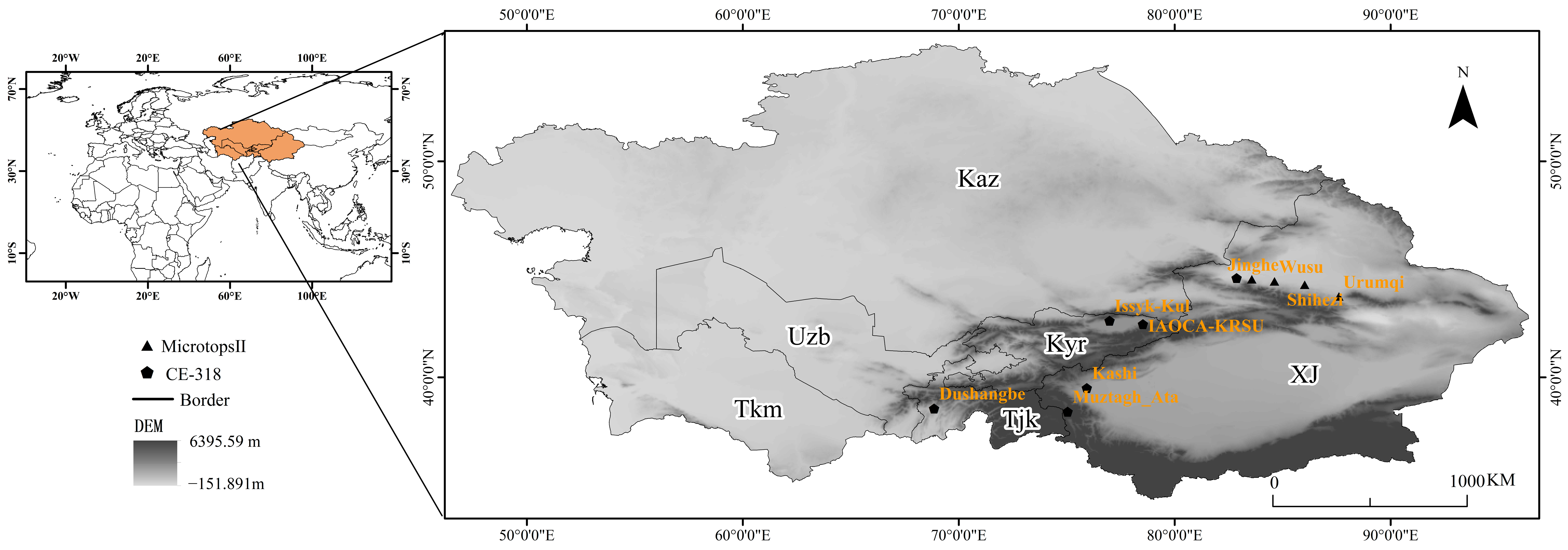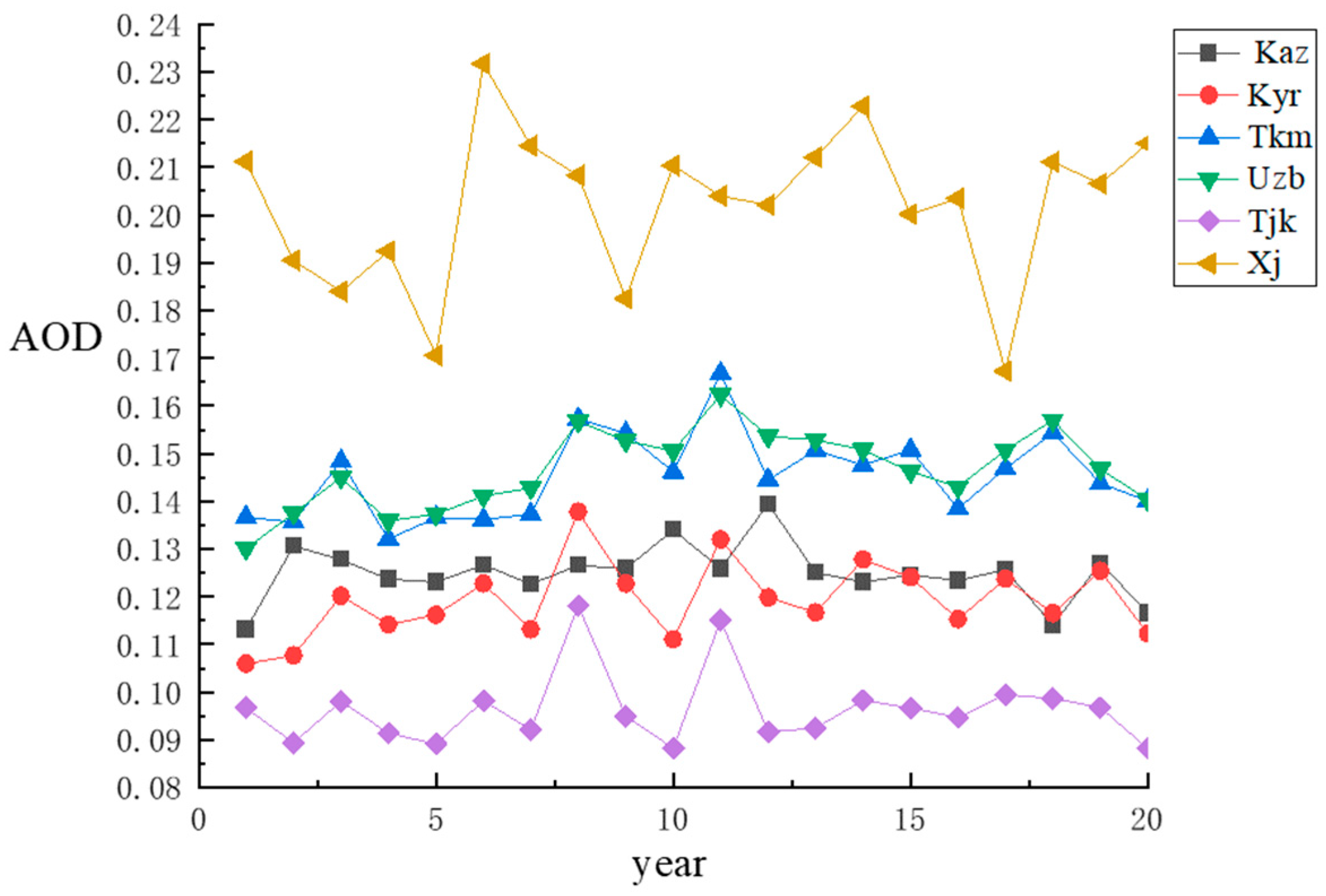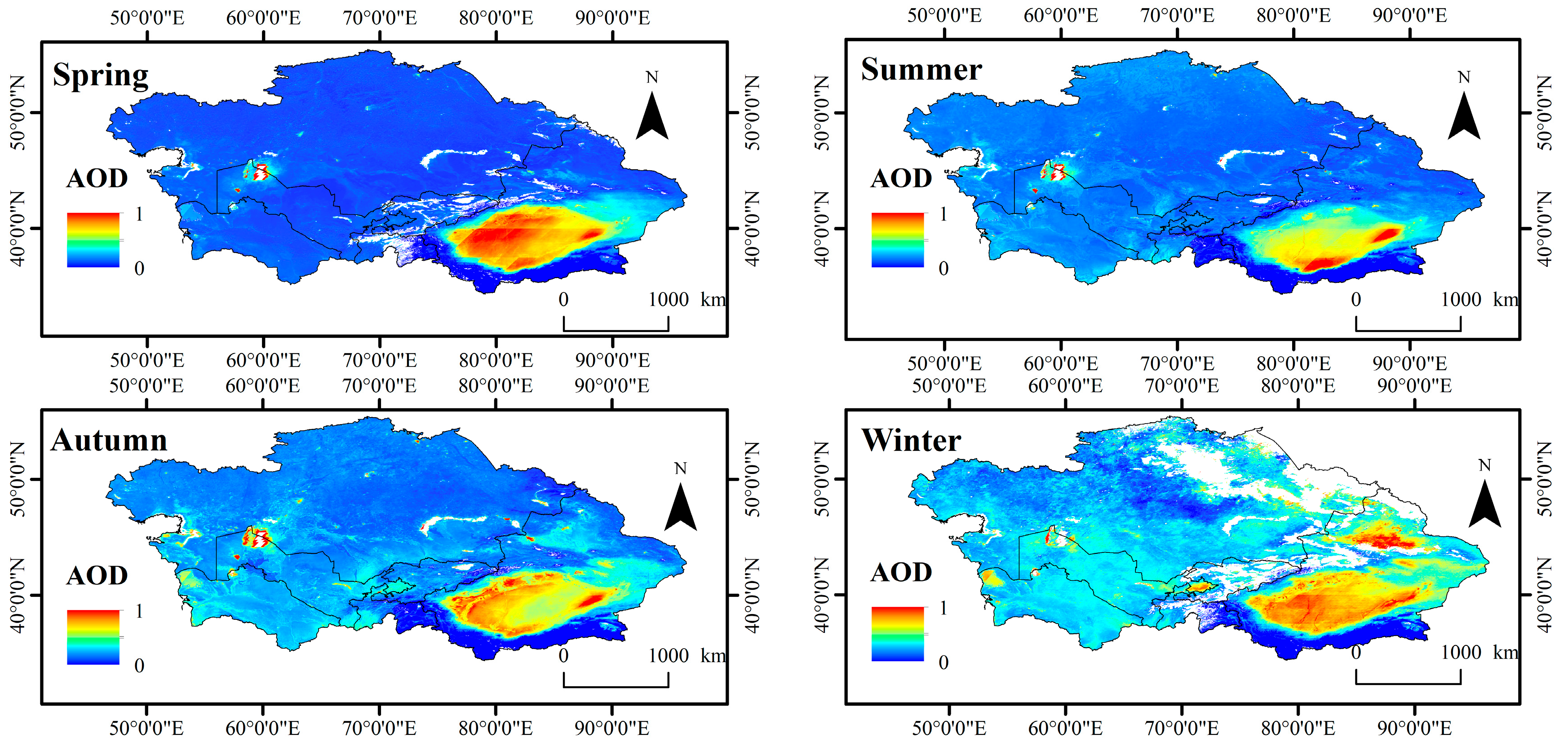Study on Accuracy Evaluation of MCD19A2 and Spatiotemporal Distribution of AOD in Arid Zones of Central Asia
Abstract
:1. Introduction
2. Materials and Methods
2.1. Overview of the Study Area
2.2. Data Presentation
2.2.1. MODIS MAIAC AOD Data
2.2.2. Solar Photometer Data
2.2.3. Meteorological Data and Vegetation Normalization Data
2.3. Methods
2.3.1. Validation Methods
2.3.2. Trend Analysis
2.3.3. Coefficient of Variation
2.3.4. The Hurst Index
2.3.5. Correlation Analysis
3. Results
3.1. MCD19A2 Applicability Assessment
3.2. Aerosol Spatial and Temporal Distribution
3.3. Interannual Variability of Aerosols
3.4. Seasonal Changes in Aerosols
3.5. Relationships between AOD, Wind Speed, and Vegetation Indices
4. Discussion
5. Conclusions
- (1)
- MCD19A2 is verified to have an underestimation phenomenon by the foundation and measured sites and shows an overestimation phenomenon at the lake and in general has good applicability in the arid zone.
- (2)
- The annual mean value of AOD in the arid zone for 20 years ranges from 0.1416 to 0.1622, with the maximum value occurring in 2006 and the minimum value in 2005. The distribution of the mean value of AOD over the past 20 years has been relatively stable, with a small degree of alteration, but the mean value of AOD has shown an overall decreasing trend, and at the same time, the mean value of AOD in spring and summer is significantly higher than that in fall and winter. With seasonal changes, the overall trend is decreasing: spring (0.1923) > summer (0.1711) > autumn (0.1254) > winter (0.1177). Poor stability is mainly in the Aral Sea and around the Tarim Basin and in areas with high human activity, and the overall differences in arid zones are significant. The characteristics of AOD persistence in China are dominated by weak antipersistence, with weak persistence and weak antipersistence distributed in a mosaic, and strong antipersistence distributed sporadically in arid areas.
- (3)
- AOD is positively correlated with wind speed and negatively correlated with NDVI, so it is very important to improve the vegetation cover in the study area.
- (4)
- In this paper, ground-based and satellite remote sensing techniques are integrated to analyze the characteristics of spatial and temporal aerosol distribution and evolutionary patterns in the Central Asian arid zone from 2001 to 2020 and to evaluate the current status of the atmospheric environment in the region. The next step will focus on the impact of aerosols on climate change and discuss in depth the influence of meteorological factors at different scales on local aerosol patterns.
Author Contributions
Funding
Institutional Review Board Statement
Informed Consent Statement
Data Availability Statement
Acknowledgments
Conflicts of Interest
References
- Mao, J.; Zhang, J.; Wang, M. Summary Comment on Research of Atmospheric Aerosl in China. Acta Meteorol. Sin. 2002, 60, 625–634. (In Chinese) [Google Scholar]
- Han, Y.; Wang, T.; Rao, R.; Wang, Y. Progress in the study of physic-optics characteristics of atmospheric aerosols. Acta Phys. Sin. 2008, 57, 7396–7407. [Google Scholar]
- Semenov, V.K. Aerosol optical depth over the mountainous region in central Asia (Issyk-Kul Lake, Kyrgyzstan). Geophys. Res. Lett. 2005, 32. [Google Scholar] [CrossRef]
- Rupakheti, D.; Kang, S.; Bilal, M.; Gong, J.; Xia, X.; Cong, Z. Aerosol optical depth climatology over Central Asian countries based on Aqua-MODIS Collection 6.1 data: Aerosol variations and sources. Atmos. Environ. 2019, 207, 205–214. [Google Scholar] [CrossRef]
- Chen, X.; Ding, J.; Liu, J.; Wang, J.; Ge, X.; Wang, R.; Zuo, H. Validation and comparison of high-resolution MAIAC aerosol products over Central Asia. Atmos. Environ. 2021, 251, 118273. [Google Scholar] [CrossRef]
- Gupta, G.; Venkat Ratnam, M.; Madhavan, B.L.; Narayanamurthy, C.S. Long-term trends in Aerosol Optical Depth obtained across the globe using multi-satellite measurements. Atmos. Environ. 2022, 273, 118953. [Google Scholar] [CrossRef]
- Lv, D.; Zhou, X.; Li, W.; Luo, Y. Analyses on the Spatial Distribution of Aerosol Optical Depth over China in Recent 30 Years. Chin. J. Atmos. Sci. 2002, 26, 721–730. (In Chinese) [Google Scholar]
- Cai, H.; Yang, Y.; Luo, W.; Chen, Q. City-level variations in aerosol optical properties and aerosol type identification derived from long-term MODIS/Aqua observations in the Sichuan Basin, China. Urban Clim. 2021, 38, 100886. [Google Scholar] [CrossRef]
- Viswanatha Vachaspati, C.; Reshma Begam, G.; Nazeer Ahammed, Y.; Raghavendra Kumar, K.; Reddy, R.R. Characterization of aerosol optical properties and model computed radiative forcing over a semi-arid region, Kadapa in India. Atmos. Res. 2018, 209, 36–49. [Google Scholar] [CrossRef]
- Kang, Y.; Wang, L.; Xin, J.; Tao, M.; Song, T.; Gong, C.; Wang, Y.; Li, G. Analysis of the Change Trend of Aerosol Single-Scattering Albedo in the Areas of Northern China Based on AERONET and OMI Data. Clim. Environ. Res. 2019, 24, 537–551. [Google Scholar]
- Niu, L.; Wang, X.; Han, H.; Liang, X.; Jiang, X.; Tan, Z.; Liu, Z. Spatiotemporal distribution of aerosol optical depth in the five Central Asian countries. Acta Sci. Circumstantiae 2021, 41, 321–333. (In Chinese) [Google Scholar]
- Zhang, Z.; Ding, J.; Wang, J. Spatio-temporal variations and potential diffusion characteristics of dust aerosol originating from Central Asia. Acta Geogr. Sin. 2017, 72, 507–520. (In Chinese) [Google Scholar]
- Liu, J.; Ding, J.; Li, X.; Zhang, J.; Liu, B. Identification of dust aerosols, their sources, and the effect of soil moisture in Central Asia. Sci. Total Environ. 2023, 868, 161575. [Google Scholar] [CrossRef] [PubMed]
- Falah, S.; Mhawish, A.; Sorek-Hamer, M.; Lyapustin, A.I.; Kloog, I.; Banerjee, T.; Kizel, F.; Broday, D.M. Impact of environmental attributes on the uncertainty in MAIAC/MODIS AOD retrievals: A comparative analysis. Atmos. Environ. 2021, 262, 118659. [Google Scholar] [CrossRef]
- Hu, J.; Zhong, K.; Kang, M.; Chen, Y.; Yang, F.; Liu, Q.; Zhang, H. Variation in aerosol optical depth over the typical cities in the Xinjiang region. China Environ. Sci. 2019, 39, 4074–4081. [Google Scholar]
- Gharibzadeh, M.; Alam, K.; Abedini, Y.; Bidokhti, A.A.; Masoumi, A. Monthly and seasonal variations of aerosol optical properties and direct radiative forcing over Zanjan, Iran. J. Atmos. Sol.-Terr. Phys. 2017, 164, 268–275. [Google Scholar] [CrossRef]
- Khademi, F.; Bayat, A. Classification of aerosol types using AERONET version 3 data over Kuwait City. Atmos. Environ. 2021, 265, 118716. [Google Scholar] [CrossRef]
- Ge, Y.; Alipu, N.; Jilili, A.; Liu, D. Dynamic Change and Potential Transport Characteristics of Dust Aerosol Originating from the Aral Sea Basin. J. Desert Res. 2016, 36, 1374–1380. [Google Scholar]
- Wu, J.; Ma, L.; Abudouwaili, J. Lake surface change of the Aral Sea and its environmental effects in the arid region of the central asia. Arid Land Geogr. 2009, 32, 418–422. [Google Scholar]
- Chen, F.; Yu, Z.; Yang, M.; Ito, E.; Wang, S.; Madsen, D.B.; Huang, X.; Zhao, Y.; Sato, T.; John, B.; et al. Holocene moisture evolution in arid central Asia and its out-of-phase relationship with Asian monsoon history. Quat. Sci. Rev. 2008, 27, 351–364. [Google Scholar] [CrossRef]
- Kloog, I.; Sorek-Hamer, M.; Lyapustin, A.; Coull, B.; Wang, Y.; Just, A.C.; Schwartz, J.; Broday, D.M. Estimating daily PM 2.5 and PM 10 across the complex geo-climate region of Israel using MAIAC satellite-based AOD data. Atmos. Environ. 2015, 122, 409–416. [Google Scholar] [CrossRef] [PubMed]
- Lyapustin, A.I.; Wang, Y.; Laszlo, I.; Hilker, T.G.; Hall, F.; Sellers, P.J.; Tucker, C.J.; Korkin, S.V. Multi-angle implementation of atmospheric correction for MODIS (MAIAC): 3. Atmospheric correction. Remote Sens. Environ. 2012, 127, 385–393. [Google Scholar] [CrossRef]
- Ångström, A. The parameters of atmospheric turbidity. Tellus 1964, 16, 64–75. [Google Scholar] [CrossRef]
- Feng, L.; Su, X.; Wang, L.; Jiang, T.; Zhang, M.; Wu, J.; Qin, W.; Chen, Y. Accuracy and error cause analysis, and recommendations for usage of Himawari-8 aerosol products over Asia and Oceania. Sci. Total Environ. 2021, 796, 148958. [Google Scholar] [CrossRef]
- Liu, F.; Zhang, Z. An improved method for retrieving aerosol optical depth over Ebinur Lake Basin from Gaofen-1. Atmos. Environ. 2023, 301, 119699. [Google Scholar] [CrossRef]
- Willmott, C.J. Some Comments on the Evaluation of Model Performance. Bull. Am. Meteorol. Socity 1982, 63, 1309–1313. [Google Scholar] [CrossRef]
- Sen, P.K. Estimates of the Regression Coefficient Based on Kendall’s Tau. J. Am. Stat. Assoc. 1968, 63, 1379–1389. [Google Scholar] [CrossRef]
- Xu, Z.; Zhao, F. Variation of Sunlight Radiation Duration in the Yellow River Basin. Resour. Sci. 2005, 27, 153–159. [Google Scholar]
- Li, G.; Zhang, J.; Wang, N.; Cheng, H.; Zhao, L. Prediction of Climate Change Trend Based on Rescaled Range Analysis and Non-periodic Cycle Analysis—A Case Study in Lanzhou City. Arid. Zone Res. 2013, 30, 299–307. [Google Scholar]
- Ma, X.; Ding, Y.; Shi, H.; Yan, W.; Dou, X.; Ochege, F.U.; Luo, G.; Zhao, C. Spatiotemporal variations in aerosol optical depth and associated risks for populations in the arid region of Central Asia. Sci. Total Environ. 2022, 816, 151558. [Google Scholar] [CrossRef]
- Ruxton, G.D. The unequal variance t-test is an underused alternative to Student’s t-test and the Mann–Whitney U test. Behav. Ecol. 2006, 17, 688–690. [Google Scholar] [CrossRef]
- Habib, A.; Chen, B.; Khalid, B.; Tan, S.; Che, H.; Mahmood, T.; Shi, G.; Butt, M.T. Estimation and inter-comparison of dust aerosols based on MODIS, MISR and AERONET retrievals over Asian desert regions. J. Environ. Sci. 2019, 76, 154–166. [Google Scholar] [CrossRef] [PubMed]
- Liu, X. Analyses of the spring dust storm frequency of northern China in relation to antecedent and concurrent wind, precipitation, vegetation, and soil moisture conditions. J. Geophys. Res. 2004, 109. [Google Scholar] [CrossRef]
- Wang, X.; Chen, Y.; Li, Z.; Fang, G.; Wang, F.; Liu, H. The impact of climate change and human activities on the Aral Sea Basin over the past 50 years. Atmos. Res. 2020, 245, 105125. [Google Scholar] [CrossRef]






| Site | Longitude | Latitude | Observation Time | Sun Photometer |
|---|---|---|---|---|
| Muztagh_Ata | 75.039 | 38.408 | June 2011–November 2011 | CE-318 |
| Issyk-Kul | 76.983 | 42.623 | August 2007–May 2016 | CE-318 |
| IAOCA-KRSU | 78.529 | 42.464 | March 2014–May 2017 | CE-318 |
| Dushanbe | 68.858 | 38.553 | July 2010–April 2018 | CE-318 |
| Kashi | 75.9304 | 39.5043 | March 2019–April 2019 | CE-318 |
| JingheⅠ | 82.864 | 44.599 | June 2019–December 2019 | CE-318 |
| Urumqi | 87.600 | 43.750 | October 2018–July 2019 | Microtops Ⅱ |
| Shihezi | 86.017 | 44.294 | May 2019–June 2019 | Microtops Ⅱ |
| Wusu | 84.620 | 44.450 | July 2015–September 2018 | Microtops Ⅱ |
| JingheⅡ | 83.568 | 44.545 | July 2015–August 2018 | Microtops Ⅱ |
| SAOD | Z-Value | Changes in AOD Trends |
|---|---|---|
| ≥0.05 | ≥1.96 | increase significantly |
| ≥0.05 | −1.96~1.96 | slight increase |
| −0.05~0.05 | −1.96~1.96 | unchanged |
| <−0.05 | −1.96~1.96 | slight decrease |
| <−0.05 | <−1.96 | significant reduction |
| Regions | Min | Max | Average |
|---|---|---|---|
| Tajikistan | 0.014 | 0.3824 | 0.0964 |
| Turkmenistan | 0.0753 | 0.4755 | 0.1462 |
| Uzbekistan | 0.0181 | 2.5329 | 0.1504 |
| Kazakhstan | 0.01399 | 2.4246 | 0.1258 |
| Kyrgyzstan | 0.106 | 0.1378 | 0.11923 |
| Xinjiang, China | 0.0139 | 1.4131 | 0.2027 |
Disclaimer/Publisher’s Note: The statements, opinions and data contained in all publications are solely those of the individual author(s) and contributor(s) and not of MDPI and/or the editor(s). MDPI and/or the editor(s) disclaim responsibility for any injury to people or property resulting from any ideas, methods, instructions or products referred to in the content. |
© 2023 by the authors. Licensee MDPI, Basel, Switzerland. This article is an open access article distributed under the terms and conditions of the Creative Commons Attribution (CC BY) license (https://creativecommons.org/licenses/by/4.0/).
Share and Cite
Zhu, Z.; Zhang, Z.; Liu, F.; Chen, Z.; Ren, Y.; Guo, Q. Study on Accuracy Evaluation of MCD19A2 and Spatiotemporal Distribution of AOD in Arid Zones of Central Asia. Sustainability 2023, 15, 13959. https://doi.org/10.3390/su151813959
Zhu Z, Zhang Z, Liu F, Chen Z, Ren Y, Guo Q. Study on Accuracy Evaluation of MCD19A2 and Spatiotemporal Distribution of AOD in Arid Zones of Central Asia. Sustainability. 2023; 15(18):13959. https://doi.org/10.3390/su151813959
Chicago/Turabian StyleZhu, Zhengnan, Zhe Zhang, Fangqing Liu, Zewei Chen, Yuxin Ren, and Qingfu Guo. 2023. "Study on Accuracy Evaluation of MCD19A2 and Spatiotemporal Distribution of AOD in Arid Zones of Central Asia" Sustainability 15, no. 18: 13959. https://doi.org/10.3390/su151813959





